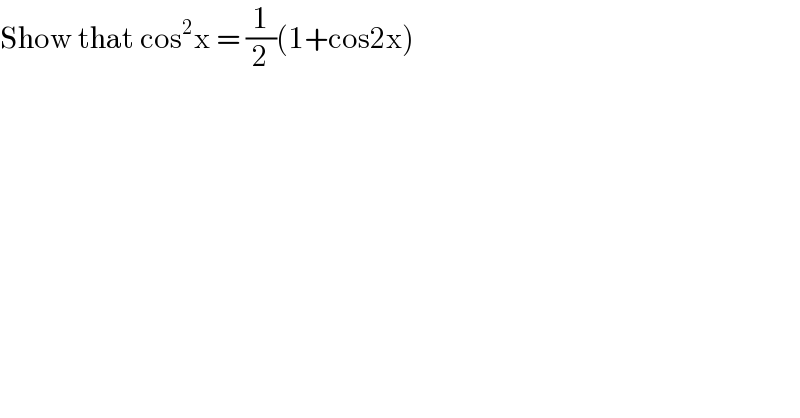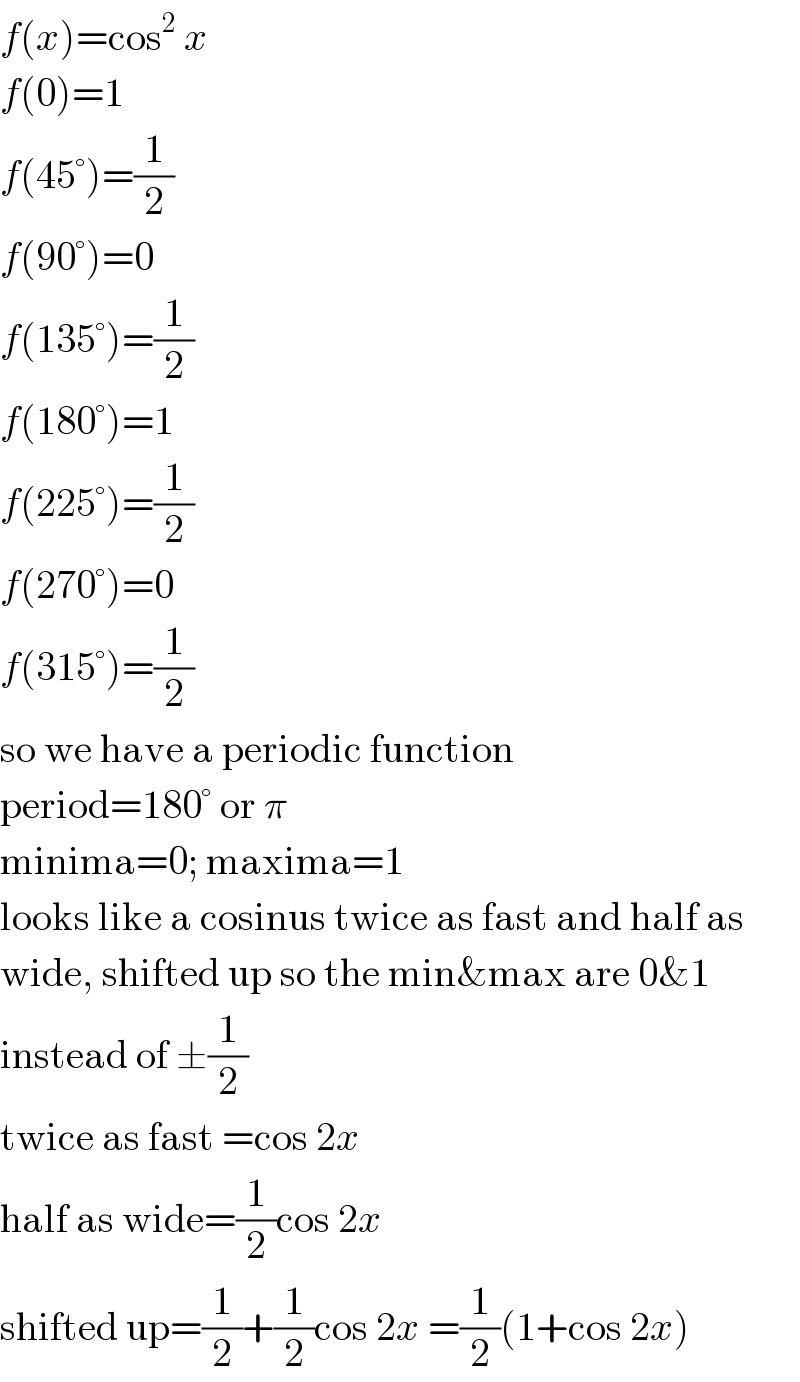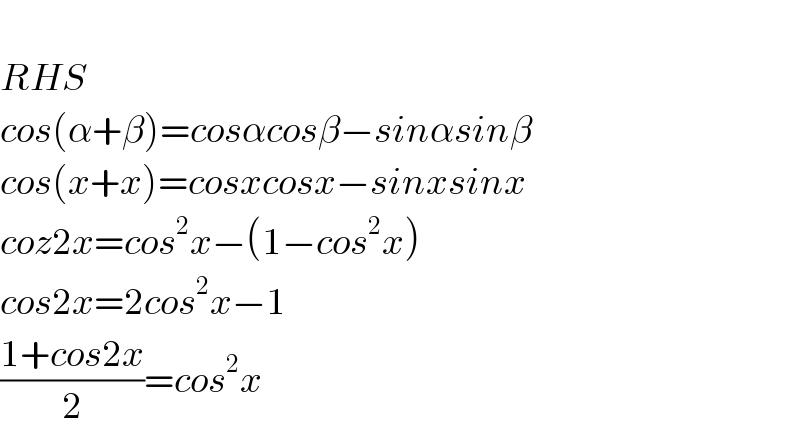Question Number 44028 by pieroo last updated on 20/Sep/18

$$\mathrm{Show}\:\mathrm{that}\:\mathrm{cos}^{\mathrm{2}} \mathrm{x}\:=\:\frac{\mathrm{1}}{\mathrm{2}}\left(\mathrm{1}+\mathrm{cos2x}\right) \\ $$
Commented by maxmathsup by imad last updated on 20/Sep/18

$${by}\:{scalar}\:{product}\:{we}\:{can}\:{prove}\:{that}\:{cos}\left({a}+{b}\right)={cos}\:{a}\:{cosb}\:−{sina}\:{sinb} \\ $$$${let}\:{take}\:{a}={b}={x}\:\Rightarrow{cos}\left(\mathrm{2}{x}\right)={cos}^{\mathrm{2}} {x}−{sin}^{\mathrm{2}} {x}\:={cos}^{\mathrm{2}} {x}\:−\left(\mathrm{1}−{cos}^{\mathrm{2}} {x}\right)\: \\ $$$$=\mathrm{2}\:{cos}^{\mathrm{2}} {x}\:−\mathrm{1}\:\Rightarrow\mathrm{1}+{cos}\left(\mathrm{2}{x}\right)=\mathrm{2}{cos}^{\mathrm{2}} {x}\:\Rightarrow{cos}^{\mathrm{2}} {x}\:=\frac{\mathrm{1}+{cos}\left(\mathrm{2}{x}\right)}{\mathrm{2}}\:. \\ $$
Answered by MJS last updated on 20/Sep/18

$${f}\left({x}\right)=\mathrm{cos}^{\mathrm{2}} \:{x} \\ $$$${f}\left(\mathrm{0}\right)=\mathrm{1} \\ $$$${f}\left(\mathrm{45}°\right)=\frac{\mathrm{1}}{\mathrm{2}} \\ $$$${f}\left(\mathrm{90}°\right)=\mathrm{0} \\ $$$${f}\left(\mathrm{135}°\right)=\frac{\mathrm{1}}{\mathrm{2}} \\ $$$${f}\left(\mathrm{180}°\right)=\mathrm{1} \\ $$$${f}\left(\mathrm{225}°\right)=\frac{\mathrm{1}}{\mathrm{2}} \\ $$$${f}\left(\mathrm{270}°\right)=\mathrm{0} \\ $$$${f}\left(\mathrm{315}°\right)=\frac{\mathrm{1}}{\mathrm{2}} \\ $$$$\mathrm{so}\:\mathrm{we}\:\mathrm{have}\:\mathrm{a}\:\mathrm{periodic}\:\mathrm{function} \\ $$$$\mathrm{period}=\mathrm{180}°\:\mathrm{or}\:\pi \\ $$$$\mathrm{minima}=\mathrm{0};\:\mathrm{maxima}=\mathrm{1} \\ $$$$\mathrm{looks}\:\mathrm{like}\:\mathrm{a}\:\mathrm{cosinus}\:\mathrm{twice}\:\mathrm{as}\:\mathrm{fast}\:\mathrm{and}\:\mathrm{half}\:\mathrm{as} \\ $$$$\mathrm{wide},\:\mathrm{shifted}\:\mathrm{up}\:\mathrm{so}\:\mathrm{the}\:\mathrm{min\&max}\:\mathrm{are}\:\mathrm{0\&1} \\ $$$$\mathrm{instead}\:\mathrm{of}\:\pm\frac{\mathrm{1}}{\mathrm{2}} \\ $$$$\mathrm{twice}\:\mathrm{as}\:\mathrm{fast}\:=\mathrm{cos}\:\mathrm{2}{x} \\ $$$$\mathrm{half}\:\mathrm{as}\:\mathrm{wide}=\frac{\mathrm{1}}{\mathrm{2}}\mathrm{cos}\:\mathrm{2}{x} \\ $$$$\mathrm{shifted}\:\mathrm{up}=\frac{\mathrm{1}}{\mathrm{2}}+\frac{\mathrm{1}}{\mathrm{2}}\mathrm{cos}\:\mathrm{2}{x}\:=\frac{\mathrm{1}}{\mathrm{2}}\left(\mathrm{1}+\mathrm{cos}\:\mathrm{2}{x}\right) \\ $$
Commented by MJS last updated on 20/Sep/18

$$\mathrm{I}\:\mathrm{thought}\:\mathrm{it}\:\mathrm{might}\:\mathrm{be}\:\mathrm{of}\:\mathrm{interest}\:\mathrm{to}\:\mathrm{show}\:\mathrm{it} \\ $$$$\mathrm{without}\:\mathrm{using}\:\mathrm{any}\:\mathrm{formula},\:\mathrm{because}\:\mathrm{the} \\ $$$$\mathrm{given}\:\mathrm{equation}\:\mathrm{is}\:\mathrm{considered}\:\mathrm{to}\:\mathrm{be}\:\mathrm{a}\:\mathrm{formula} \\ $$$$\mathrm{itself}… \\ $$
Answered by tanmay.chaudhury50@gmail.com last updated on 20/Sep/18

$$ \\ $$$${RHS} \\ $$$${cos}\left(\alpha+\beta\right)={cos}\alpha{cos}\beta−{sin}\alpha{sin}\beta \\ $$$${cos}\left({x}+{x}\right)={cosxcosx}−{sinxsinx} \\ $$$${coz}\mathrm{2}{x}={cos}^{\mathrm{2}} {x}−\left(\mathrm{1}−{cos}^{\mathrm{2}} {x}\right) \\ $$$${cos}\mathrm{2}{x}=\mathrm{2}{cos}^{\mathrm{2}} {x}−\mathrm{1} \\ $$$$\frac{\mathrm{1}+{cos}\mathrm{2}{x}}{\mathrm{2}}={cos}^{\mathrm{2}} {x} \\ $$
Answered by $@ty@m last updated on 20/Sep/18

$${We}\:{have} \\ $$$$\mathrm{cos}\:\left({a}+{b}\right)=\mathrm{cos}\:{a}.\mathrm{cos}\:{b}−\mathrm{sin}\:{a}.\mathrm{sin}\:{b} \\ $$$${Put}\:{a}={b}={x} \\ $$$$\mathrm{cos}\:\mathrm{2}{x}=\mathrm{cos}\:^{\mathrm{2}} {x}−\mathrm{sin}\:^{\mathrm{2}} {x} \\ $$$$\:\:\:\:\:\:\:\:\:\:\:\:\:=\mathrm{cos}\:^{\mathrm{2}} {x}−\left(\mathrm{1}−\mathrm{cos}\:\:^{\mathrm{2}} {x}\right) \\ $$$$\:\:\:\:\:\:\:\:\:\:\:\:\:=\mathrm{2cos}\:^{\mathrm{2}} {x}−\mathrm{1} \\ $$$$\Rightarrow\mathrm{2cos}\:^{\mathrm{2}} {x}=\mathrm{1}+\mathrm{cos}\:\mathrm{2}{x} \\ $$
